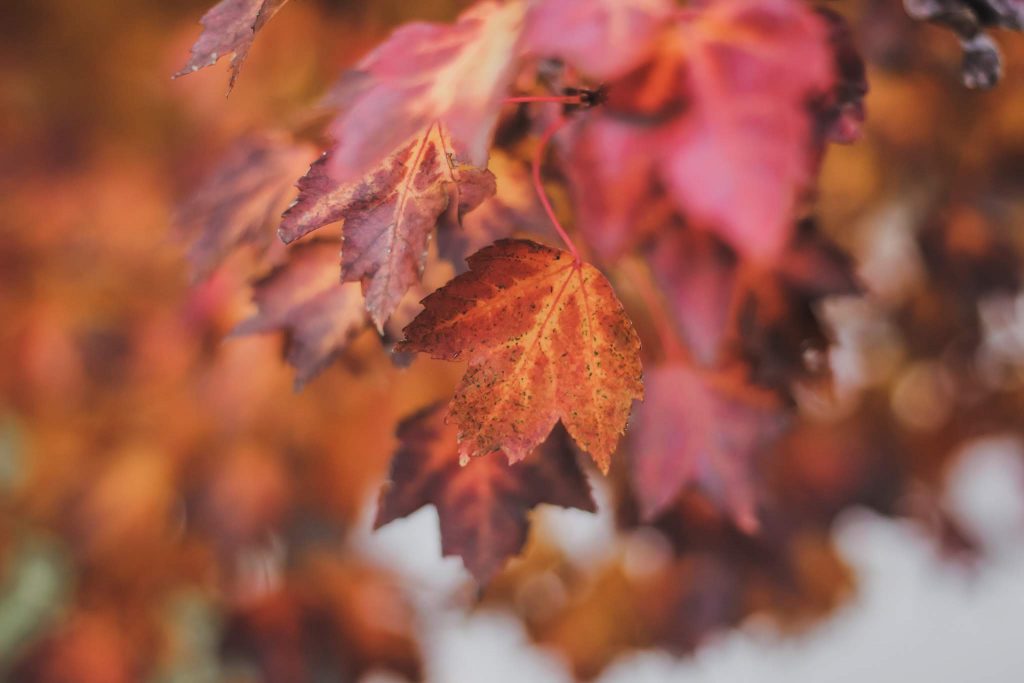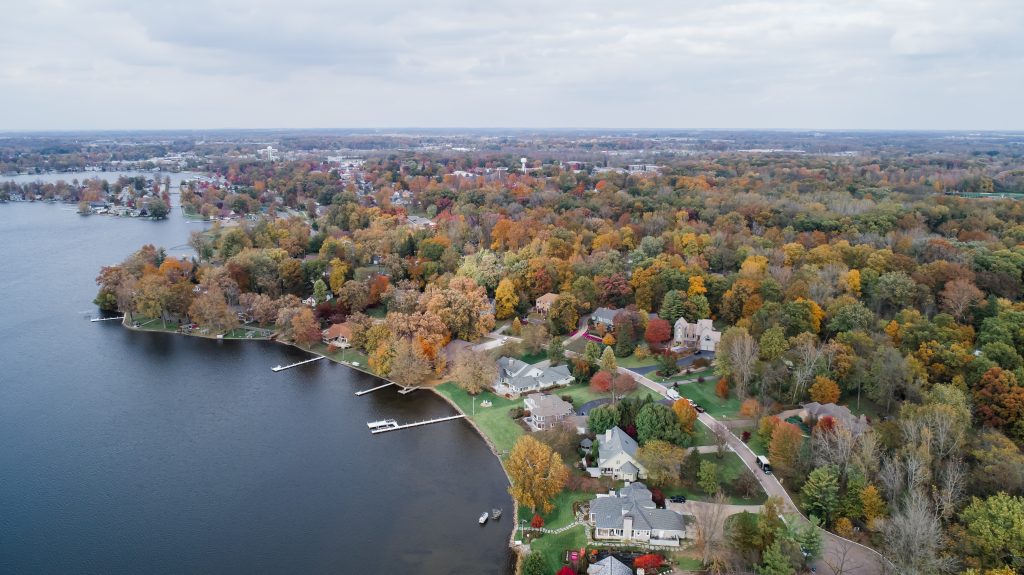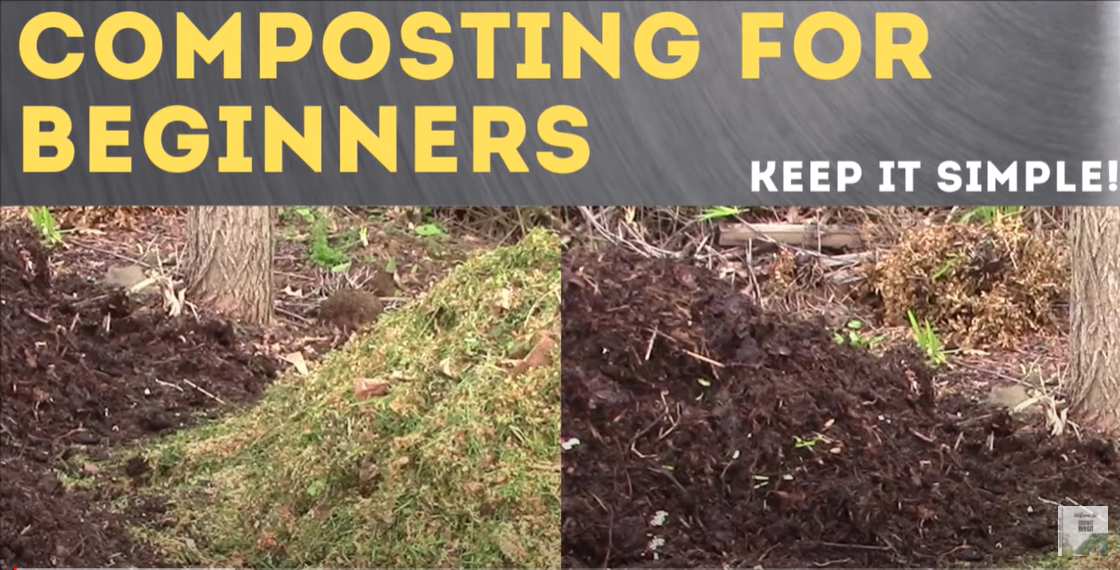What happens when leaves fall into lakes? And other autumnal questions.
During warmer months, your family probably stores autumn and winter decorations in the attic or basement. Around the holidays, these decorations make special appearances when they are needed most: pumpkins at Halloween, turkeys at Thanksgiving, and stockings at Christmas.
You might be surprised to learn that the lake ecosystems do something similar … but with nutrients!
Nutrients are substances that plants use as fuel. They are found in almost everything, and are released after that plant, animal or other organism has decomposed. Around lakes, nutrients commonly enter the water through eroding shorelines, lawn and garden fertilizers, grass clippings – and leaves.

What causes the leaves to change color in the fall?
Before leaves fall from the trees, they turn a wide variety of autumnal colors. Here’s how the Farmers’ Almanac describes the process:
The vivid, often simple colors on the outside are the products of the complex chemistry of growth inside a leaf. The green chlorophyll, the workhorse of photosynthesis, dominates and covers up those carotenoids in summer. As the days grow shorter and the temperatures cool, chlorophyll degrades and goes from green to colorless, allowing the oranges and the yellows to show up.
Farmers’ Almanac, What Causes Leaves To Change Color?
But those ruby-red crimson hues we see on red maples, black gums, dogwoods, sourwood, and oaks? Those come from a pigment called anthocyanin. Not all trees produce anthocyanin, and those that do only produce it under certain circumstances.
Although there are a number of theories trees produce the red pigment, one prevailing reason is to act as “sunscreen.” As the tree prepares for winter, it sends anthocyanin into the leaves, protecting the leaves from sunlight while the tree draws in any remaining nutrients (in the form of sugars).
“If it’s been especially rainy and overcast, you won’t see much red foliage,” writes Jennifer Horton, contributing author at How Stuff Works. “Without bright sunlight, the trees don’t need the added protection that the red pigments provide, so they don’t bother producing them.”
When do leaves fall? And how do impact the lakes' health?
According to the Farmer’s Almanac, peak autumn color can be enjoyed from October 5-21 in northern Indiana. After that, they’ll begin to accumulate on lawns, in gutters … and in the lakes.
When leaves are put in the lake during the fall – either because they blow in or are dumped there – they become a stored nutrient, just like your winter decorations during the summer. You don’t use holiday decorations year-round, and neither will nutrients be used until they are needed most.
Stored nutrients are a problem when the weather warms up. Algae and weeds are primarily dormant during the winter, but when spring comes, they use stored nutrients to flourish. That frequently results in algae blooms and an overabundance of weeds, both of which can harm animals in the lake and prevent your ability to fully enjoy the lake.

What can I do with leaves, besides throw them away?
This autumn, collect your leaves for removal according to your local guidelines, or use them to create a healthy compost pile. The organic matter found in compost provides structure to the soil, captures water for roots to soak up, and resists compaction and erosion. It gives plants the nutrients they need to grow.
Unfortunately, compost is typically associated with a smelly, steaming pile of old kitchen scraps and weeds hidden in a forgotten corner of the yard. When done correctly, compost can be a much classier (and much more useful) means to a robust harvest of fruits and vegetables!
There are four key categories to a healthy compost pile:
- 25-50% Browns: Carbons, such as leaves, shredded paper or paper towel
- 50-75% Greens: Kitchen scraps, grass and plant clippings
- Air: You’ll need to turn your compost pile once per week
- Water: And keep it damp, like a wrung-out sponge
The key, says Sarah Baier, our education program specialist, is to “attract the FBI to your decay scene.” A healthy compost will be home to fungus, good bacteria and insects. These little workers will digest the browns and greens, and infuse the pile with the nutrients and microbes that plants need.
Ideally, your compost pile will be built in layers, beginning and ending with the browns. If you’re going to add anything to a compost pile, Sarah says, add a little extra of the browns. But, she cautions, “If the pile is dry, add greens. You want the pile to feel hot and smell like fresh soil.”
The carbon in the browns will help the compost stay less wet, and help achieve the perfect pH balance. “A good balance of browns and greens will keep the compost cooking, and keep those nutrients and microbes alive,” Sarah added.
Here are a few more tips and tricks:
- If you keep your pile enclosed, make sure air and rain can still reach it. A fully enclosed compost pile won’t be useful to your garden.
- Keep a closed container in your kitchen for dumping scraps. Compost piles are vegetarians — no meat scraps or bones are allowed, unless you want to attract snakes and other critters! Here’s a complete list of compost dos and don’ts from the EPA.
- Don’t want to stab a shovel into your compost pile? Sarah suggests using a wingdigger.
Leaves are also an excellent source of all-natural mulch! Turn leaves into mulch by shredding them with a mulching lawnmower, or similar process. (If you don’t chop them into small pieces, they won’t decompose well during the winter and you’ll be raking them up again in the spring.) Spread them in a thin layer over landscaping beds, or in a slightly thicker layer over cold-hardy vegetables.
Even though the impact of proper leaf disposal will not be immediately visible, you are helping the local lakes and their inhabitants stay healthy!

How to compost at home
Prefer to watch rather than read? This 18-minute tutorial will walk you through the basics of composting, what materials to gather and how to get started. You’ll help keep leaves out of lakes in no time!